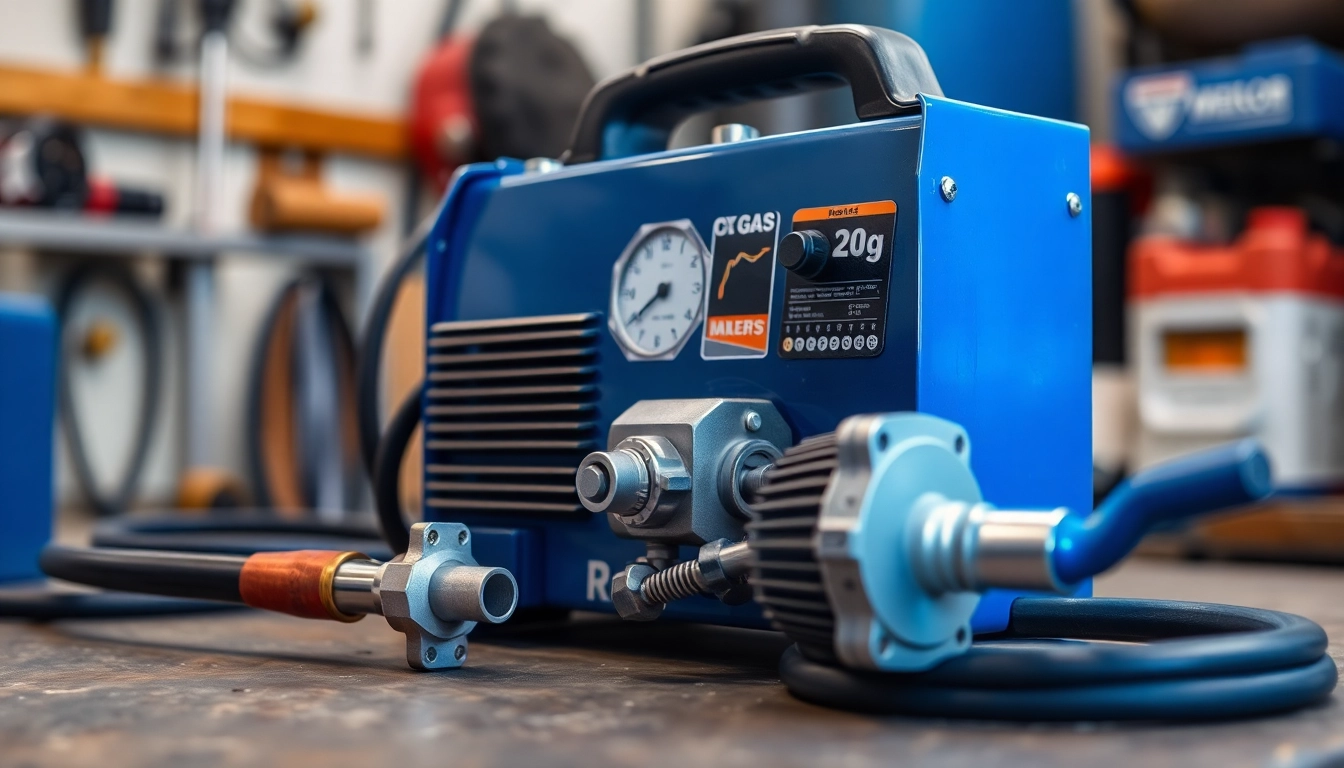Introduction to Oxy Gas Welding Kits
Oxy gas welding, a process that utilizes a mixture of oxygen and fuel gas to create a high-temperature flame, is a common method used in various welding applications. Such tools are essential for those involved in construction, metalworking, and repairs. Among the vital equipment in this domain is the oxy gas welding kit, which typically includes essential components for both welding and cutting applications. This article explores the landscape of oxy gas welding kits, discussing their benefits, key features, comparative analyses of popular brands, user guidance, troubleshooting tips, and maintenance practices.
What is an Oxy Gas Welding Kit?
An oxy gas welding kit consists of all necessary components to utilize oxy-fuel welding effectively. Typically, these kits include an oxygen cylinder, a fuel gas cylinder (such as acetylene), hoses, welding torches, regulators, and various attachments. When combined, these components allow users to create an intense flame suitable for melting and joining metal pieces efficiently. Oxy-acetylene is the most commonly used type of oxy gas welding and is renowned for its versatility in applications from light to heavy-duty welding. Categories of oxy gas welding kits range from light-duty models for basic household repairs to heavy-duty kits designed for industrial applications.
Benefits of Using Oxy Gas Welding Kits
Oxy gas welding kits offer several benefits that contribute to their widespread usage across different sectors:
- Versatility: Oxy gas welding can be employed for various tasks including welding, cutting, brazing, and soldering. This makes it a multi-functional option for metalworkers and fabricators.
- Temperature Control: Users can achieve a wide range of temperatures, allowing for precise control over melting and joining capabilities. The oxy-acetylene flame can reach temperatures of around 3,200°C (5,792°F), making it ideal for welding materials such as steel and aluminum.
- Portability: Most oxy gas welding kits are designed to be portable. This feature is beneficial for job-site projects, enabling users to transport their tools easily.
- Cost-Effectiveness: Compared to other welding processes, particularly MIG or TIG welding, oxy gas welding equipment tends to have a lower initial investment. This makes it an accessible choice for hobbyists and small businesses.
- Ease of Use: With proper training, oxy gas welding can be learned quickly, making it an excellent choice for new welders.
Key Features to Look For
When selecting an oxy gas welding kit, it’s essential to consider the following key features:
- Regulators: High-quality regulators that ensure stable pressure levels are crucial for safe and effective operation.
- Torch Design: Look for a lightweight torch that is easy to maneuver. Adjustable flame features are also advantageous for various welding applications.
- Compatibility: Ensure that the kit components are compatible with tanks and other accessories you may already own.
- Safety Features: Integrated safety features such as flashback arrestors and check valves help prevent accidents during operation.
- Customer Support: Reliable customer support and warranties can enhance the purchasing experience, offering peace of mind in case of issues.
Comparative Analysis of Popular Oxy Gas Welding Kits
Top Brands and Models
Several top brands dominate the market for oxy gas welding kits, each offering unique features and price points. Here are a few that stand out:
- Victor Technologies: Known for high-quality, durable kits, Victor models like the Victor G150 offer an extensive range of capabilities, suitable for both professional and entry-level welding.
- Harris: Harris welding supplies are famous for their reliable performance and are known to cater to both industrial and DIY projects. Their kits often receive favorable customer reviews.
- Crown: Offering affordable yet reliable products, Crown welding kits are ideal for those new to oxy gas welding or working on lighter materials.
- LINCOLN Electric: Renowned for robust and advanced technology, Lincoln Electric’s kits are tailored for serious metalworkers and industries requiring high-performance solutions.
- Unimig: Their oxy gas welding kits are particularly notable for their combination of quality and value, making them popular among hobbyists and professionals alike.
Pricing Overview and Value
Prices for oxy gas welding kits can vary significantly based on brand, included components, and intended use. Entry-level kits may be found for as little as $100, while professional-grade sets can range from $300 to over $1,500. Here’s a concise breakdown:
- Budget Kits ($100 – $300): Suitable for hobbyists, these often come with basic features and components.
- Mid-Range Kits ($300 – $600): Ideal for small businesses and aspiring professionals. These kits provide a balance of quality and capabilities.
- Professional Kits ($600+): Designed for heavy-duty use, providing advanced features and top durability. These are commonly favored in industrial applications.
Customer Reviews and Ratings
Analyzing customer feedback and ratings is a crucial part of research when considering which oxy gas welding kit to purchase. Reviews can often highlight real-world performance, including ease of use, durability, and customer service. Here are common themes based on user experiences:
- Durability: Many users appreciate kits that withstand rigorous use over time, with solid builds and high-quality materials.
- Ease of Setup: Positive reviews frequently mention simple assembly and scripting processes which reduce user errors.
- Customer Support: Brands that offer accessible customer support and warranties tend to receive higher ratings as users find reassurance in their purchases.
Step-by-Step Guide to Using an Oxy Gas Welding Kit
Safety Precautions and Best Practices
Before attempting to use an oxy gas welding kit, safety should be the primary concern. Below are essential safety precautions:
- Protective Gear: Always wear appropriate gear, including welding helmets, gloves, jackets, and safety glasses to protect against sparks and harmful fumes.
- Check Equipment: Inspect hoses and connections for leaks, and ensure the integrity of tanks and fittings before operation.
- Ventilation: Work in a well-ventilated area to prevent the accumulation of harmful gases; this is particularly important when working with acetylene.
- Storage: Store gas tanks upright and secure, away from heat sources, and ensure hoses are coiled and protected from damage.
Setting Up Your Oxy Gas Welding Kit
Proper setup of your oxy gas welding kit is essential for effective and safe operation. Follow these steps:
- Gather Your Components: Ensure that all components of your kit are available and in good condition.
- Attach Regulators: Securely attach the regulators to the oxygen and acetylene tanks with the correct fittings.
- Connect Hoses: Connect the hoses to the torch, ensuring that the acetylene hose is tightly affixed to the red connection and the oxygen hose to the green connection.
- Open Valves: Begin by opening the acetylene valve slightly, and follow with the oxygen valve to adjust for the desired flame characteristics.
- Check for Leaks: Use a soap solution around the connections to identify any leaks by looking for bubbles forming.
Techniques for Effective Welding
Mastering oxy gas welding techniques is key to successful welds. Here are some effective strategies:
- Adjust Flame Characteristics: Achieve the right flame type—neutral, oxidizing, or carburizing—based on the metal type and thickness.
- Welding Angles: Keep the torch at a correct angle (typically 60 degrees) toward the weld line for optimal penetration.
- Feeding Filling Rods: Practice feeding filler rods into the molten puddle to aid in the welding process without disrupting the weld pool.
- Speed Control: Control your welding speed to ensure consistency in weld bead width and depth.
Common Problems and Solutions with Oxy Gas Welding Kits
Frequent Issues Faced by Users
Despite their popularity and ease of use, users may encounter common challenges when working with oxy gas welding kits. Some frequent issues include:
- Flame Instability: Caused by improper gas pressure settings or leaks.
- Backfires: Frequent backfires may indicate faulty equipment or incorrect gas mixture ratios.
- Poor Welding Quality: Issues like porosity or weak joints often stem from wrong torch angles or improper metal preparation.
Troubleshooting Tips
Addressing these issues may involve several troubleshooting tips:
- Check Gas Levels: Ensure both oxygen and acetylene tanks have adequate fuel to achieve stable flame conditions.
- Inspect Hoses for Damage: Look for cracks or wear on hoses that may cause gas leaks, and replace them if necessary.
- Adjust Flame Settings: Re-evaluate and adjust the flame settings to attain the proper size and type for the metal being welded.
When to Seek Professional Help
Sometimes, issues may arise that require professional assistance. Seek help if you:
- Consistently face severe safety concerns or accidents.
- Are unable to repair equipment effectively.
- Feel uncertain about maximizing the use of your welding kit.
Maintenance and Care for Longevity
Cleaning and Storage Tips
Regular cleaning and proper storage are essential to extending the life of your oxy gas welding kit:
- Post-Use Cleaning: After use, clean the welding torch tips and hoses to remove any metal debris or flux that may affect future performance.
- Storage Conditions: Store your kit in a dry place, away from moisture and extreme temperatures to prevent corrosion and equipment degradation.
- Inspect Regularly: Periodically inspect the condition of hoses, fittings, and tanks to identify potential problems before they escalate.
Regular Maintenance Practices
To ensure optimal performance, follow regular maintenance practices:
- Change O-Rings: Regularly replace O-rings on your hoses and fittings to prevent leaks.
- Calibrate Regulators: Periodically calibrate regulators to ensure accurate pressure settings.
- Professional Servicing: Consider annual maintenance checks by certified professionals, particularly for high-use kits and tanks.
Replacement Parts and Upgrades
As with any tool, certain components may need replacement over time to maintain functionality:
- Hoses: Replace any damaged or worn hoses to ensure safety.
- Regulators: Upgrade to higher-quality regulators for better precision and performance.
- Portfolio Enhancement: Consider adding specialized welding attachments as you advance in your skills to cater to more specific applications.






















+ There are no comments
Add yours